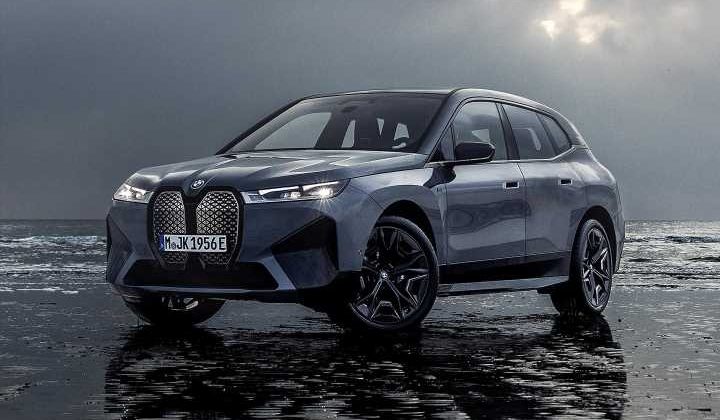Not sold on BMW's latest SAV just yet? Maybe 619hp will help
By Matt Bird / Wednesday, January 5, 2022 / Loading comments
Even with exceptionally powerful EVs established in the fast car sphere, a new model can still defy belief with some silly numbers. Take the new BMW iX M60, the first M car “designed for purely electric mobility from the outset”. Bet we never imagined it looking like this. But here’s a BMW that weighs at least 2,585kg (that’s the xDrive 50 weight; there isn’t one for this yet), producing 619hp and 749lb ft from a 105.2kWh battery and two chunky motors. Everything about the iX M60 is vast apart from, of course, the 0-62mph time: thanks to its 811lb ft (!) overboost, BMW claims 3.8 seconds. Top speed climbs substantially over the regular iX, too, this one nudging 155mph like a proper M car. Which will probably get through your range pretty swiftly…
This being an M car, however – “the best of three worlds i, X and M”, no less – the latest iX is about rather more than just straight-line wallop. Its front double wishbones and rear multi-link axle have been specifically tuned for the M60 installation, with adaptive air suspension at both ends alongside new dampers. The latter include “an M specific characteristic via continuously adjustable valves”, which can apply the required damping force in milliseconds. Given the suspension progress made in M cars recently – the new M3 and M5 CS are especially good at managing their mass – there might be hope yet for the iX M60. With four-wheel steer, sports brakes, “powerfully dimensioned” anti-roll bars, and optional sticky tyres, there’s plenty you might expect to find in a flagship BMW. Predictably, an “emotionally powerful” driving experience is promised.
In normal driving, the iX M60 is rear-drive only, which helps contribute to its maximum range rating of 352 miles. The front wheels are engaged only when required, via electric all-wheel drive and the actuator-based wheel slip limitation seen in cars like the Mini Electric. BMW suggests that torque distribution between motors and axles is executed more quickly and “with significantly higher control quality” than could happen with a transfer case. The motors themselves are said to operate at up to 93 per cent efficiency; the front delivers 258hp, the rear 489hp.
Power consumption is rated at between 24.7 and 21.6 kWh per 100km, or between 2.5 and 2.9 miles per kWh. BMW is very proud of the motor design, eliminating as it does the need for rare raw materials; as for the rest, we’ll defer to the release: “The two motors of the BMW iX M60 operate on the principle of a current-energised synchronous machine. Instead of permanently installed permanent magnets, the excitation of the rotor is triggered by thee precisely metered supply of electrical energy.” In case you were wondering.
This being a BMW M flagship as well as an EV milestone for the manufacturer, there’s no way the M60 could look like any old iX. Surely a good thing, many will say, but there’s only so far Titanium Bronze accents, optional 22-inch aero wheels, and M brake calipers will get you – the new model is still going to divide opinion. At least that fearsome acceleration means it won’t be in view for long.
Set to debut at the Consumer Electronics Show later this month – which says a lot about the car’s remit – it is the M60’s job, alongside the i4 M50, to establish EVs as legitimate M cars. Obviously you could argue that a 2.5-tonne SAV, even one with “high performance characteristics”, isn’t the most natural place to begin, but BMW is determined. “The performance characteristics of the iX M60 are not only characterised by fascinatingly spontaneous acceleration, but also by outstanding cornering dynamics and handling that can be precisely controlled at all times, even in highly dynamic situations.” And there have been unexpectedly great BMW M cars in the past – maybe, just maybe, this might be another. We’ll find out in the summer.
- 2022 BMW iX xDrive 50 | PH Review
- 2021 BMW M5 CS | PH Review
Source: Read Full Article
